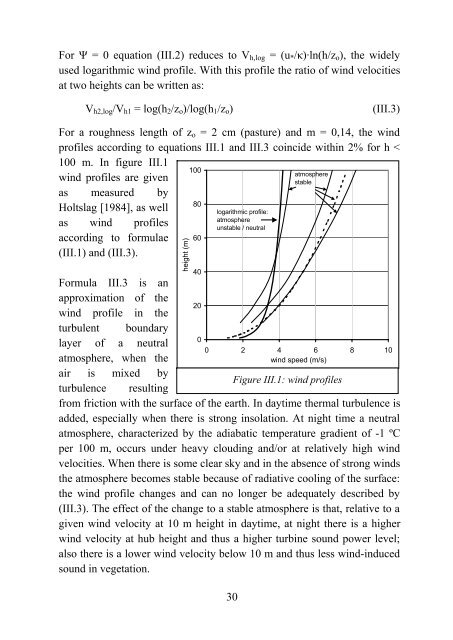The sounds of high winds
The sounds of high winds
The sounds of high winds
Create successful ePaper yourself
Turn your PDF publications into a flip-book with our unique Google optimized e-Paper software.
For = 0 equation (III.2) reduces to V h,log = (u * /)·ln(h/z o ), the widely<br />
used logarithmic wind pr<strong>of</strong>ile. With this pr<strong>of</strong>ile the ratio <strong>of</strong> wind velocities<br />
at two heights can be written as:<br />
V h2,log /V h1 = log(h 2 /z o )/log(h 1 /z o )<br />
(III.3)<br />
For a roughness length <strong>of</strong> z o = 2 cm (pasture) and m = 0,14, the wind<br />
pr<strong>of</strong>iles according to equations III.1 and III.3 coincide within 2% for h <<br />
100 m. In figure III.1<br />
wind pr<strong>of</strong>iles are given<br />
as measured by<br />
Holtslag [1984], as well<br />
as wind pr<strong>of</strong>iles<br />
according to formulae<br />
(III.1) and (III.3).<br />
Formula III.3 is an<br />
approximation <strong>of</strong> the<br />
wind pr<strong>of</strong>ile in the<br />
turbulent boundary<br />
layer <strong>of</strong> a neutral<br />
atmosphere, when the<br />
air is mixed by<br />
turbulence resulting<br />
height (m)<br />
100<br />
80<br />
60<br />
40<br />
20<br />
0<br />
logarithmic pr<strong>of</strong>ile:<br />
atmosphere<br />
unstable / neutral<br />
0 2 4 6 8 10<br />
wind speed (m/s)<br />
from friction with the surface <strong>of</strong> the earth. In daytime thermal turbulence is<br />
added, especially when there is strong insolation. At night time a neutral<br />
atmosphere, characterized by the adiabatic temperature gradient <strong>of</strong> -1 ºC<br />
per 100 m, occurs under heavy clouding and/or at relatively <strong>high</strong> wind<br />
velocities. When there is some clear sky and in the absence <strong>of</strong> strong <strong>winds</strong><br />
the atmosphere becomes stable because <strong>of</strong> radiative cooling <strong>of</strong> the surface:<br />
the wind pr<strong>of</strong>ile changes and can no longer be adequately described by<br />
(III.3). <strong>The</strong> effect <strong>of</strong> the change to a stable atmosphere is that, relative to a<br />
given wind velocity at 10 m height in daytime, at night there is a <strong>high</strong>er<br />
wind velocity at hub height and thus a <strong>high</strong>er turbine sound power level;<br />
also there is a lower wind velocity below 10 m and thus less wind-induced<br />
sound in vegetation.<br />
30<br />
atmosphere<br />
stable<br />
Figure III.1: wind pr<strong>of</strong>iles
















